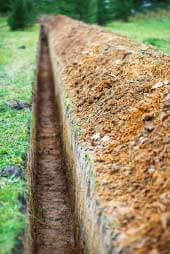Of course, when you talk about surface drainage and sub surface drainage there are a whole lot more sub-divisions, as it were;
Surface Agricultural Drainage – Natural Drainage Systems

These are generally open type ditches which are placed to carry the water from areas of land which have got too much of it or are prone to becoming water-logged to areas in need of water or natural rivers / run off areas. Farmland needs water but too much of it is definitely a bad thing.
- Open ditch drains – these are largely irregular and follow the contours of the land.
- Field ditches – are designed and placed on purpose. They are usually pretty deep with V shaped or vertical sides and narrow tops so that they can easily be crossed by heavy farm machinery – you don’t want your tractor falling into an agricultural drainage ditch after all.
- Narrow ditches – are generally the type of agricultural drainage ditch used in places where large pieces of farm machinery aren’t in use.
Subsurface Agricultural Drainage / Underground Drainage
Underground drainage systems are designed to remove any excess water for the soil and do have a number of advantages over the above ground, surface drainage systems. For one thing they don’t get in the way of operations around the farm and there is no wasted land taken over for ditches . . . on the other hand they are a more costly option.
These subsurface agricultural drains are generally;
- Box drains
- Pipes / tile drains
- Rubble – gravel or coarse stones can provide subsurface drainage areas
- Mole drains – are particularly useful in heavier clay soils and commonly used in Europe
- Drainage pumps
 English
English Français
Français Deutsch
Deutsch español
español Italiano
Italiano 日本語
日本語 Eλληνικά
Eλληνικά русский
русский

